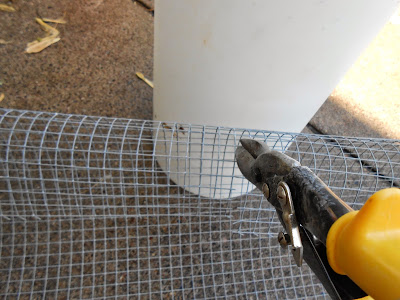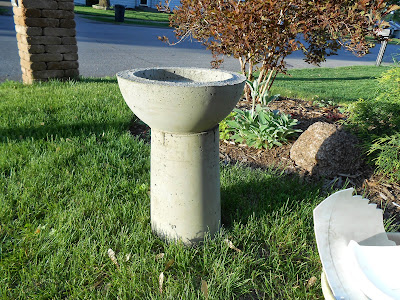Here is what you will need:
1. A pair of good gloves
2. Dust mask
3. Something to mix the concrete with (trowel, hoe, etc)
4. Molds
5. Mold release spray-I use cheap cooking spray
6. Hardware cloth or chicken wire for reinforcement
7. Wheelbarrow or tub large enough to mix the concrete in
8. Concrete or a cement recipe of your choice, I used Quikcrete Commercial Grade Crack Resistant (for durability in my zone 5 climate)
9. Water
10. Pair of cutters to trim the hardware cloth
Here are the steps to create your own masterpiece:
1. Pick a set of molds-you will need three pieces for a birdbath. I went around the house and garage and put pieces together to see what looked interesting and picked what I liked best. Note: the inner mold should be no more than 2 inches because birds do not like deep water.
 |
| Some of the "molds" that I was considering |
2. Clean and dry the molds you are going to use.
3. Trim your hardware cloth to fit in the molds-make sure it is smaller than the mold.
For the bowl:
4. Cover any holes in the molds with tape:
5. Oil the molds:
Take a paper towel and wipe off excess:
All ready to go:
6. Dump concrete mix in tub or wheelbarrow (I used 2 bags which was more than enough for the size of molds I had chosen):
7. Add water as recommended by manufacturer, I always start with less water and add it as needed. Too much water weakens the concrete.
8. Begin mixing-I like to mix with my hands and a handheld hoe.
 |
| This is the consistency I prefer |
 |
| Press it down in the mold |
Add concrete around and inside the hardware cloth pressing it down as much as you can to release air bubbles:
 |
| Fill in the sides and the middle-continue pressing it down |
 |
| Press as you add concrete |
Now the other mold:
 |
| Fill the bottom |
 |
| Add hardware cloth |
 |
| Time to add the inner mold |
 |
| Set it in the outer mold, center as much as you can |
 |
| Add concrete around the sides |
 |
| Press it down to get rid of air bubbles |
 |
| Add caption |
 |
| All filled-I added more weight to keep the inner mold in place |
10. Cover them with plastic and let them set up (in a level area if possible) for approximately 24 hours.
11. After 24 hours unmold them somewhere soft. Some will slip right out:
and some will be difficult (plastic can be cut off):
These two I had to crack the plastic off:
12. Cure for a week covered with plastic make sure they stay moist, or use a water bath. I prefer to cure my concrete in a water bath. I use my pond when it is clean or you can use large plastic tubs/storage containers.
13. Seal the concrete or paint it-I use Rustoleum water based concrete seal.
14. Place them out in the garden for the birds (if you are worried about the top falling off you can use construction adhesive to attach the top to the bottom):
There you are-sturdy, durable birdbaths that you can make for a fraction of what it costs to buy one from a retailer. Remember, you can embellish them if you would like. Just do it after you fill the molds (while still wet), you can press gems, stones or shells into the rim or glue leaves in the molds themselves before you spray them with mold release. Either way, I think you will love your results.
So, until next time-Happy Planting!
Rhonda















































































